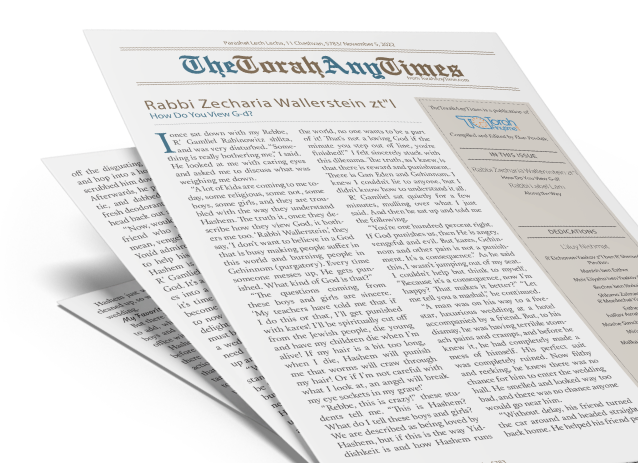Rabbanit Amit Yaghoubi
Seeing G-d Behind the Mask
The Megillah read on Purim is called “Megillat Esther,” explained by Chazal to be a play on two words. Megillah stems from the word gilui, revealed, while Esther cognately relates to the word hester, hidden. The merging together of Megillat Esther balances the hidden and the revealed. On a personal, introspective level, it forces us to enter into our lives and examine everything we take for granted and recognize the hidden miracles.
Although we live during a time of hester panim when Hashem’s presence is opaque, He is still very much orchestrating the events of the world behind the scenes. As Rabbi Avrohom Sutton observes, the word “history” is phonetically similar to the word “hester,” hidden. “History” is “His story.” It is G-d’s story whereby global and personal events are guided by His Divine hand. Hidden within history is His story.
In the words of the Baal Shem Tov, that which most succinctly depicts the hester of our lives and the lives of our ancestors is the game of hide and seek. Throughout history, Hashem plays “hide and seek” with us.
Imagine a young child playing this game with his friends. As he is running around and having a good time, he eventually comes across the perfect hiding spit. Although his friends begin searching for him, they are at a loss to find him. Where has he gone? The boy continues to play along with his friends, while his father stands away at a distance smiling. He knows his son’s friends are nowhere near finding him.
Peeking out at his father from his hiding spot, the boy whispers, “Abba, can I come with you?” Looking back at his son, the father dissuades him. “Don’t move; you have the best spot!” “But I just want to say hello,” whispers back the boy.” “Trust me,” reiterates the father, “just stay where you are.” The son trusts such advice and listens, as his father continues to look on with a wonderful feeling.
As the boy grows older and matures, though, so do his games. Every now and then, when the father steps in to take a look at his son, the son yearns to join his father. But each time the response is the same, “Stay where you are.”
Finally, there comes a point where the boy grows older and his games are now heavily intricate. Engrossed in the glamour of the game, the son no longer thinks about his father. As time progresses even further, the son soon forgets about him altogether.
But then everything changes one day. “Where is my father?” wonders the boy, “I really miss him. He always used to show up, but I haven’t seen him in such a long time.” A few days later, the son is in for a big surprise. He at last sees his beloved father. Unsatisfied to merely wave at him from a distance, the son races over to give his father a big hug. “Abba,” says the son, “this time I am not leaving you. I missed you so much; I want to follow you all around. Arm in arm, we will never again separate from one another.”
This is the story of our lives, explains the Baal Shem Tov. On a national level, Hashem every so often peeks out at us and reveals Himself. And when that occurs, it is a breathtaking revelation. All we can say is, “Zeh Keli v’anveihu – This is my G-d and I will glorify Him.” Throughout Tanach, the Jewish nation was privy to open miracles of immense proportion. But as time moved forward, with the destruction of the Beit Hamikdash, Hashem moved into the background. We no longer saw Him on front and center stage. And especially nowadays, with the opening of the newspaper, we are heartbroken to read of tragedy after tragedy and illnesses and hardships rampantly affecting people every which way we turn.
But we mustn’t forget that Hashem is part and parcel of our lives as a nation. Every so often, if we are keen to observing, He ever so slightly reveals Himself in our day and age, as during the miracle of Purim. It may be a “hidden miracle,” and require us to carefully connect the dots to see the hidden hand, but it is certainly there.
The same is true on a personal level. Throughout our daily lives, Hashem appears every so often. And when that happens, we come to realize, “Hashem, you are really looking after me.” Living with such an inspirational high, we feel Hashem is inseparably a part of our daily lives.
Learning the Lessons of Life
But to a certain degree, even while we feel He is involved in our world, it appears as if He wishes for us to stay preoccupied in our game called life. He doesn’t want us to say, “I have seen Hashem and now let me excuse myself from the game.” He wants us to continue playing. If we would have left when we first sighted Him, it would have been a premature and rash decision. He wishes for us to continue in life in this world keenly aware that He exists and is constantly a part of our lives, despite His presence being hidden.
Only after learning the lessons of life and accomplishing that which we have been sent down to earth for, will we then be able to leave the game. At that point, we will be capable of embracing Hashem and remaining with Him forever in the World to Come. But as long as we remain in our earthly station, we are to continue learning the lessons and truths of life.
Imagine a student sitting in a class distracted and drawing a picture. He is clearly not paying attention. How will the teacher get the child to focus on the material being learned? Announce, “This is going to be on the test!” When children hear this, their attitudes immediately shift. They change gears and realize that they are in school to learn.
Our lives here in this world are akin to a child in a school surrounded by teachers. When we begin to zone out and lose focus, all we must do is alert ourselves to the reality that we are here in this world to learn lessons and pass the test of life. If we are remiss in alerting ourselves, Hashem sends others to wake us up and bring us to realize that we ought to redirect our focus. During the days of Purim, it was Haman who woke us up to this reality, and spurred us to repenting and reaccepting to adhere to the Torah, as we received it on Har Sinai.
Our Two Tools: Tefillah and Torah
Every child needs his supplies to make it successfully through school, though. And indeed, in order to avoid getting completely lost in the games of this world, Hashem has granted us two tools: Torah and Tefillah. These two tools are inseparably united. Only are we most effectively able to connect to Hashem in Tefillah when we are connected to Torah.
What does the Torah teach us? Exploring its main themes, it is clear that Hashem repeatedly tries to show us that He exists in this world. Whether it be the mass preaching of belief in G-d by Avraham Avinu or the story of the Megillat Esther or the intimate relationship conveyed in Shir HaShirim, throughout Tanach, one clear theme is stressed time and again. “My children, I exist in this world. You may not be able to see me, but I am here.”
Tefillah focuses on the same theme. A true, heartfelt Tefillah is offered when one searches deep in the recesses of his or her heart and seeks to fulfill Hashem’s will. When one yearns that G-d be recognized and seen by all of mankind, one’s entire approach to Tefillah dramatically changes. This is the meaning behind the dictum, “Aseh retzono kir’tzonecha – Make His will like your will” (Avot 2:4). Such a perspective indelibly impacts one’s outlook. It is no longer, “Hashem, save me!” It is rather “Hashem, help me see You in this situation.”
Often times we feel that we alone need to solve our own problems. But then Hashem reminds us, “Don’t just tell Me to solve the problem; ask that you be able to see Me in your problem.” Whatever we are dealing with, the greatest solution is being able to see Hashem in that difficulty.
The climax of Tefillah is Shemonah Esrei, known as the Amidah. Amidah literally means “Standing.” Why do we refer to prayer with such a term? Herein lays one of the greatest truths. Sometimes we feel that we are standing stagnant in life and not going anywhere. But the reality is that at that very moment we are right before the Kisei Hakavod. All we must do in order to see G-d is remove the barriers of our mind.
It is for this reason that when we pray we close our eyes. Our physical location appears to constrain and confine us. It seems to hold us down and keep us motionlessly standing. But the truth is that as we pray, we are meant to think of ourselves as changing locations. We may be physically thousands of miles away, but we are in fact standing in Yerushalayim, on Har Habayit and in the Kodesh Hakodashim.
Anyone who has ever dreamed or been stimulated by imagination has experienced such a phenomenon. Located in one place, our minds take us somewhere else. Tefillah is about removing the barriers of our mind in order to clearly experience G-d. The message is that even as we stand, we can travel to the greatest of spiritual revelations and heights.
Our second tool provided to us in this game of life is the Torah. Learning about the greatness of our ancestors, we gain a glimpse into the lives of human beings who led larger than life roles and revealed G-d’s cosmic plan. They were human beings with physical qualities and characteristics, yet rose above and beyond the limits we believe man can achieve. In their unparalleled greatness, they revealed G-dliness into the world and played an integral role in His ultimate plan of world history.
Learning about the lives of our Avot and Imahot, however, entails much more than a peripheral study. We are meant to deeply connect with them and integrate their life messages and lessons into our own lives. If they were capable of seeing Hashem in every aspect of the world, we can do the same.
It is through these two means – removing the barriers of our mind and recognizing that each of us is part of G-d’s overarching scheme of world history – that we create a most intimate relationship with Him. And this is achieved on Purim. When we connect to Hashem in Torah and Tefillah and see His involvement in our lives, we will achieve the greatest degree of closeness we can with Him, and merit experiencing His full presence in our world with the heralding of Mashiach.



